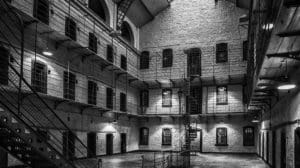Holy Wells and Sacred Trees: Ireland’s Ancient Landscapes of Faith Explored

Updated On: April 21, 2024 by Noha Basiouny
Ireland’s historical landscape is a tapestry rich with sacred sites, interwoven with the spirituality of its past and the cultural practices of its present. The country’s holy wells and sacred trees are living remnants of these traditions, firmly rooted in the physical and spiritual realms of Irish heritage. These sites have served as focal points of worship, healing, and community gatherings for centuries, reflecting the intertwining of natural elements and the divine within Celtic and later Christian belief systems.
Often nestled in picturesque landscapes, holy wells are more than just natural springs; they are vestiges of Ireland’s pagan past and its transformation through the spread of Christianity. The sacred trees that often accompany these wells stand as symbols of life, wisdom, and continuity, linking the heavens and the earth in a cycle of growth and renewal. Together, they make up a uniquely Irish living landscape of belief, where the echoes of ancient rites mingle with contemporary practices, and where every stone and stream is steeped in stories of saints, miracles, and the enduring power of faith.
Table of Contents
History of Holy Wells and Sacred Trees in Ireland
In this section, we explore the transformation of holy wells in Ireland from ancient pagan shrines to centres of Christian worship, their association with St. Patrick, and their enduring place in Irish folklore.
From Pagan to Christian Practices
Originally, the Celts revered natural springs as the dwelling places of deities, recognising the power of place and the sacredness of water. With the arrival of Christian missionaries, these sites were often Christianised, creating a symbiotic relationship between older pagan deities and new Christian beliefs. This transition was facilitated by the Roman Church, which allowed for the integration of local practices into the Christian fold, fostering a smooth conversion process for the Celtic people.
Legends of St. Patrick and the Holy Wells
St. Patrick, a figure pivotal to Ireland’s conversion to Christianity, is intrinsically linked with several holy wells. Legend has it that he used these wells to baptise converts and as a means to defy pagan gods. By many accounts, St. Patrick blessed and dedicated numerous springs to Christian saints, thus consolidating the place of the holy well within the Christian tradition of Ireland.
The Role of Holy Wells in Irish Folklore
Irish folklore is rich with tales associated with the mystical properties of holy wells. Attributes such as healing powers for both physical ailments and spiritual maladies are a common theme. Moreover, these wells often hold annual patterns or gatherings that sustain local traditions and community bonds. As enduring elements of Ireland’s landscape, holy wells continue to be an expression of Ireland’s living heritage, remaining significant within the fabric of Irish cultural identity.
The Sacred Essence of Water

The relationship between the Irish landscape and its sacred water sources is deeply entwined with the cultural and spiritual life of the country. We explore the specific qualities that make holy wells revered and the traditional uses of water as a natural resource.
Healing Properties of Holy Wells
Holy wells across Ireland are renowned for their healing properties. Each well is traditionally believed to provide a cure for different ailments, with some wells known for healing eye problems and others for treating skin conditions. The wells are often named after saints, and the water within them is considered sacred due to its association with these holy figures. Rituals, such as rounds or patterns, involve the act of visiting a well, praying, and sometimes leaving offerings. As we find in accounts of Ireland’s Wonderful Holy Wells, these practices have been a crucial part of the local heritage and continue to be an important aspect of the living landscapes of belief.
Holy Wells as Water Sources
Apart from their spiritual significance, holy wells have served as vital water sources for local communities. The waters from these wells are often crisp, clear, and unpolluted, and thus they were historically used for daily needs such as drinking and bathing. Even the waters closer to the sea are considered sacred, with some communities believing in the healing properties of the salty waters. The significance of these holy sites transcends their immediate utility, embodying a connection to the sacred that informs our understanding of these landscapes.
Cultural Significance and Ritual Practices

In the tapestry of Irish tradition, holy wells and sacred trees hold a profound place within the cultural and spiritual life of the country. Here, we look at the annual celebrations and customs tied to these living landscapes of belief.
Annual Celebrations: Pattern Days
Pattern Days are traditional Irish feast days where pilgrims gather at holy wells and sacred sites to perform rituals and blessings. These specific days, often tied to the feast day of a saint, see communities taking part in pilgrimages to engage in prayer, reflection, and renewal of faith. Circular walks around the well, known as doing the rounds, involve the recital of prayers at each station of the circle.
Offerings are also a crucial part of Pattern Days. Pilgrims commonly leave offerings at holy sites, such as coins at the well’s base or tying cloths, known as clooties or rags, to nearby trees. The clootie tree often stands as a rag tree laden with tokens of hope and healing from those who have visited, each piece of fabric embodying a prayer or wish left by someone in search of solace or intervention.
The Natural and Supernatural

In Ireland’s landscapes of belief, the intertwined nature of the sacred and the profane serves as a backdrop to a rich tapestry of myth and spirituality. The following sections will outline how natural features are often perceived as gateways to the supernatural realm.
Supernatural Elements of Sacred Sites
In the sacred landscapes of Ireland, elements of nature are commonly fused with Irish mythology and lore, giving rise to a plethora of supernatural entities and narratives. Sacred water sources, for instance, are thought to possess healing properties and retain links to the Otherworld—a realm in Irish mythology parallel to our own. Legends tell of supernatural fish that inhabit these waters, embodying wisdom and prophecy.
Holy wells dot the landscape, esteemed not just for their natural beauty but for their mystical connections to saints and deities from pagan traditions. Each well, from the Spring well in Aghvilly, Co. Down, to St. Gobnait’s in Co. Cork, is steeped in stories of miraculous cures and ancient ceremonies, highlighting the enduring belief in the sacred essence of water.
Trees and Wells as Gateways to Otherworld
Ancient trees of Ireland, such as the mighty oak and the sacred hawthorn, are perceived as potent symbols standing at the threshold between the physical and the spiritual. They serve as pillars holding up the heavens or as markers to an entrance to the Otherworld. It’s not uncommon for trees at sacred sites to be festooned with ribbons and offerings, a testament to their enduring spiritual significance.
Wells, juxtaposed with these revered trees, are also seen as portals, offering entry to enigmatic realms beneath the earth. The stories enveloping these wells often speak of a world just beyond human perception, where gods and fairies intervene in the affairs of mortals.
By understanding these natural and supernatural connections, we appreciate the complexities of a landscape where belief is woven into the very fabric of the land. These places are not just elements of the environment; they are living pieces of a much broader narrative, inviting us to witness the harmony of Ireland’s physical and metaphysical heritage.
Sacred Sites and Their Environmental Impact

Ireland’s sacred sites, comprising holy well sites and sacred trees, are deeply interwoven with our cultural and ecological heritage. These living landscapes of belief not only serve as places of spiritual significance but also play a crucial role in the resilience and conservation of the environment.
Conservation of Holy Well Sites
We understand that the conservation of holy well sites is essential for maintaining the historical and cultural continuity of these spaces. The reverence for these sites often leads to a protective attitude towards the surrounding environment. Greenery and clear waters at these locations are seen as integral to the sacredness of the well. For instance, Our ancient landscapes: Holy wells in Ireland emphasises how the community’s engagement with these wells helps preserve the natural state.
Environmental Impact: A major ecological benefit stemming from sanctified sites is the minimal environmental disturbance due to the traditional beliefs that guard against excessive exploitation or development. This often leads to the safeguarding of biodiversity and contributes to the ecological resilience of these areas. Moreover, the cultural value attributed to these sites translates into active heritage conservation. The environmental impact, therefore, is predominantly positive, as these landscapes are preserved not just in spirit but in physical form as well.
Specific Holy Wells and Their Stories
In this section, we explore individual tales of holy wells, focusing on their unique histories and the legends that cloak them within the lush Irish landscapes.
Sligo’s Holy Wells
Sligo, known for its rich spiritual past, is home to several revered holy wells. Tobernalt Holy Well is one such sanctuary, nestling near the shores of Lough Gill. It has served as a pilgrimage site, pre-dating the arrival of Christianity in Ireland. Tradition has it that this well is a place of healing and renewal, and it is especially flocked by pilgrims on Garland Sunday. Also imbued with history is Inishmurray, an abandoned island off the Sligo coast, where ancient church ruins and a holy well vividly speak of early monastic life.
The Enigmatic Wells of Meath
The county of Meath, replete with historical significance, shelters numerous mystifying holy wells. An example is St. Brigid’s Well near Kildare which plays a central role in both pre-Christian and Christian narratives. As an aspect of the landscape associated with the ancient goddess Brigid and later with one of Ireland’s patron saints, this well is entwined with legends of fertility and blessings. Likewise, Tobar Patrick in Balbriggan acts as a testament to the enduring legacy of St. Patrick, with many anecdotes of how Ireland’s patron saint blessed these waters.
Ritual Objects and Offerings

In exploring Ireland’s living landscapes of belief, we encounter a wealth of tradition in the ritual objects and offerings at holy wells and sacred trees. These practices, deeply rooted in the nation’s spiritual history, allow us a glimpse into the sacred world where nature intertwines with the divine.
The Significance of Rags and Stones
Rags (also known as clooties): Upon visiting a holy well, we often find it adorned with rags tied to the surrounding trees. These are not mere pieces of fabric; they are tangible marks of the supplicants’ prayers and wishes. It’s customary for individuals to tie rags to the branches after washing or bathing in the holy water, a practice believed to transfer illness or misfortune from the person to the rag. This act is a poignant display of hope and faith, leaving behind a symbolic offering in exchange for healing and blessings.
Stones: Standing stones can sometimes be spotted near the holy wells. These stones may bear intricate carvings and often serve as focal points for offerings. Visitors place stones on top of or around these ancient markers with great reverence, a practice that may date back to pre-Christian times. Each stone contributes to a collective testament of belief, with each addition further sanctifying the site.
While offerings like rags and stones are individual acts, they cumulatively create a communal tapestry of devotion, where each thread and pebble tells a story of humanity’s enduring connection to the sacred in nature.
Christian Influence on Irish Sacred Sites
The emergence of Christianity profoundly reshaped Ireland’s spiritual landscape, blending and redefining ancient customs with new religious practices.
The Intersection of Christianity and Local Beliefs
Ireland’s sacred sites are a testament to a unique religious amalgamation where Christianity melded with the local pagan traditions. One can observe this blend at holy wells scattered throughout the island. Originally revered in pagan customs, these wells became sites of Christian prayer as they were often dedicated to saints and the Holy Trinity. It’s not uncommon to find a graveyard adjacent to a holy well, signifying its continued sacred status through the ages.
Among these sites, the sign of baptism under Christianity formed a link where the sanctity of water from ancient beliefs persisted in the Christian ritual. Local stories often credit saints with the creation or blessing of these wells, integrating them into Christian narratives. A visit to Ireland’s holy wells will likely coincide with remnants of these customs, such as clooties—pieces of cloth—tied to trees as part of a healing ritual that intertwines with prayers for wellbeing.
Indeed, the very landscape of Ireland is etched with this rich spiritual history where natural sites once dedicated to pre-Christian gods are now named after Christian figures. To this day, special Masses and gatherings take place at these wells, especially on patron Saints’ feast days, emphasising the sites’ enduring importance in the communal expression of faith.
The synthesis of beliefs also extends to sacred trees, which hold a space within both the old and new belief systems. Known as ‘bile’ in old Irish, these trees, particularly yews and ash, were seen as guardians and were often places of assembly in pre-Christian times. With the advent of Christianity, they continued to be cherished, now often found within the sacred enclosure of a church or near a holy well.
These living landscapes of belief speak to a history where Irish Christianity adapted and absorbed elements of the indigenous spirituality and vice versa, leading to a cultural continuity that has shaped the nation’s identity and retained its spiritual heritage.
Folk Beliefs and Practices
Rooted in Irish culture, holy wells and sacred trees are enveloped by a tapestry of folk beliefs and practices that continue to resonate through time.
The Continuity of Traditional Rituals
Many holy wells in Ireland are thought to possess healing properties, and communities often engage in ‘patterns’, or pilgrimages, to these sites. These practices include specific rituals such as the circling of the well, the offering of prayers, and the tying of cloths or ‘clouties’ to nearby trees as a form of appeal or thanks. Despite the passage of centuries and the introduction of the Penal Laws, which sought to suppress such practices, the steadfast belief in the well’s power of healing and fertility has ensured their survival.
Modern-Day Interpretations of Old Customs
Modern interpretations of these ancient customs are often a blend of past beliefs with contemporary spirituality. Sacred trees, especially, are revered as sources of wisdom and connections to the otherworld. Still, today, people visit these places hoping to draw upon the perceived energy, seek charm against misfortune, or simply connect with the heritage of their ancestors. These sites have been respected and maintained, as seen in the care taken to prevent their contamination and the reverence for the folklore surrounding them.
Sacred Trees: Symbols of Life and Wisdom
Sacred trees are not just central to Irish mythology and spirituality; they embody deep-seated symbols of life and wisdom. Across Ireland, these living monuments, known as ‘bile’, have historically marked places of assembly and worship, often associated with ancient goddesses and spiritual insight.
The Hazel Tree: A Source of Poetic Inspiration
The hazel tree holds a venerable position in Celtic lore. It is traditionally associated with knowledge and poetic inspiration. According to legend, hazelnuts fell into the Well of Wisdom, imbuing the salmon that ate them with all the world’s knowledge. Moreover, hazelwood has been used to create Ogham staves, instruments of divination and writing, connecting the tree even more profoundly with wisdom and insight.
Frequently Asked Questions
In exploring Ireland’s living landscapes of belief, we encounter a rich tapestry of culture steeped in history and spirituality. The following questions shed light on how these sacred sites form an integral part of the Irish cultural landscape.
What is the significance of sacred trees within Irish cultural landscapes?
Sacred trees in Ireland, often known as “fairy trees,” hold a central place in Irish folklore. They are traditionally believed to be the dwelling places of spirits and are integral to various local customs, conveying a deep respect for nature within Irish culture.
How are holy wells integrated into local Irish customs and practices?
Holy wells are frequently tied to local patterns and pilgrimages, where communities gather to honour saints or seek healing. Customs such as ’rounding’—the practice of walking around the well a certain number of times—are part of this integration into local life.
Can you describe the historical role of holy wells in Irish spiritual life?
Historically, holy wells have been venerated as sites of spiritual significance, often dedicated to saints. The tradition of visiting these wells dates back to pre-Christian times when they were associated with deities and the natural world.
What types of rituals are traditionally performed at Irish sacred trees?
At sacred trees, it’s common to find rituals that include leaving offerings or tokens, such as tying ribbons or pieces of cloth to branches. These offerings are made with the intent of seeking blessings or healing from the spirit of the tree.
In what ways have holy wells been preserved and protected in Ireland?
Holy wells have been preserved through local stewardship and recognition of their cultural value. Efforts include clearing and maintenance of the sites, as well as respecting the wells during land development to ensure their survival for future generations.
What are the common legends or mythologies associated with Ireland’s holy wells?
Many holy wells are linked to stories of saints performing miracles, such as Saint Patrick banishing serpents or Saint Brigid’s well springing forth for the faithful. They are also often associated with local tales of healing and visions, adding a mystical dimension to their allure.






